|
|
Gondolette

|
|
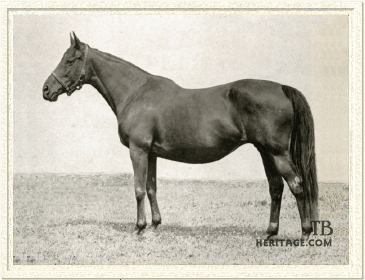 |
|
|
After a racing career which could be charitably described as mediocre, Gondolette became an enormously successful broodmare, holding the distinction of residing in the paddocks of two of Britain's most influential breeders. She was the dam of two classic winners, and of two exceptionally good producing daughters.
Gondolette was bred by Henry Waring of Beenham, near Reading, and foaled in 1902. She was not fashionably bred, for her sire, Loved One, was a stallion who started his stud career in Ireland covering hunters, while her dam, Dongola, nineteen years of age when Gondolette was foaled, had previously produced nothing of any exceptional merit.
Loved One, was merely a useful sort, both on the track and at stud. He was bred by the colorful and temperamental Caroline, Duchess of Montrose. Loved One's sire, See Saw, won the Cambridgeshire Stakes and the Royal Hunt Cup, and was sent to stud in France, where he got two good stayers and sires, Grand Prix de Paris winner Bruce and Little Duck, winner of the Grand Prix de Paris and the Prix du Jockey Club. Sire of See Saw was Royal Hunt Cup and July Stakes winner Buccaneer, a good stallion, who sired two English classic-winning daughters in Formosa and Brigantine. But this was not enough to keep him in England, and Buccaneer was exported to Hungary, where he became both a champion sire and champion broodmare sire. The sire of Buccaneer was Wild Dayrell, a winner of the Epsom Derby. This was not a particularly strong sire line, nor very popular.
As a racetrack performer, Loved One scored only three victories in minor races -- the Cheveley Stakes, the Home-bred Foal Post Stakes, and at three, the Workingham Stakes -- racing for the Duchess. Her death in 1894 led to the dispersal of her bloodstock. His mediocre race record was not guaranteed to have breeders clamoring for the services of Loved One for their mares. Despite the fact that he was well-related -- he was a son of Pilgrimage, winner in 1878 of both the Two Thousand Guineas (over subsequent Epsom Derby winner Sefton) and the One Thousand Guineas, and a half-brother to Derby winner Jeddah and Oaks heroine Canterbury Pilgrim -- he wound up being sold to William Alexander, a man who lived in the Sligo region of Ireland. There, Loved One was used to cover hunter and harness mares for a few guineas each.
Loved One sired Jockey Club Plate winner Dinna Forget and winner Little Sweetheart during his exile in Ireland. Upon the death of Mr. Alexander, Loved One was purchased by Andrew Brown, a Doncaster horse dealer, for a little over 1000 guineas and sent back to England, where he stood the remainder of his life at Henry Waring's Beenham Stud. During this time, Loved One's stud fee was never extravagant, the highest being 50 guineas in 1899, the year his son Dinna Forget won at Liverpool and Kempton Park. By the time of his death in 1907, Loved One's fee was only 19 guineas.
Loved One sired a total of 31 winners, but the most notable of his foals were Gondolette and another Beenham-bred filly, Doris. The latter was sold as a yearling at Ascot in 1899 for 730 guineas. She won two races during her career, and then went on to become a successful broodmare for Jack Barnato Joel, her offspring including Princess Dorrie, winner of the One Thousand Guineas and Oaks; Sunstar, winner of the Derby; and other stakes winners White Star, Radiant, and Bright.
Gondolette's dam, Dongola, had no racing merit, running down the course in her only start as a two-year-old. The only thing to recommend her as a potential broodmare was her parentage. She was a daughter of Derby winner Doncaster, sire of such standouts as classic winners Bend Or and Farewell. Dam of Dongola was Douranee, a daughter of the good sire Rosicrucian. The next dam, Fenella, was by Cambuscan, renowned as the sire of the unbeaten Hungarian mare Kincsem.
The immediate female family of Dongola was unimpressive. It was necessary to go back to her fifth dam to find an animal of classic caliber, and that was the French-bred Lanterne, victress of the Prix de Diane and the Prix du Jockey Club in 1844. The family traced back to Horatia, whose daughters, Juno and Sister to Juno, produced Derby winners Young Eclipse and Diomed, respectively. This was a good classic family for the first several years of the nineteenth century. Then the family regressed until the appearance of Lanterne. After Lanterne, the family again receded into the background, until the appearance of Fenella, whose daughters Oriole, Orsova, and Douranee, resuscitated the family fortunes.
Oriole became the dam of the Kilwarlin colt Ogden, imported into the United States where he captured the prestigious Futurity Stakes for owner John Madden. Orsova founded a family which became important in Germany, with such members as Csardas, Orchidee, Indigo, and Oleander. Douranee, in addition to Dongola, foaled a three-quarter sister to that filly. By Bend Or, and called Quetta, she became the dam of the striking gray stakes winner Grey Leg.
When Gondolette was a yearling and sent to the Ascot sales in 1903, the exploits of Orsova's family were still far in the future. Her best recommendation at that time from a family standpoint came from the racing class of her relatives Grey Leg and Ogden. Thus, being by a mediocre sire out of a non-winning mare from a family which had not produced much of any quality for several generations, it was not surprising that interest in Gondolette was low. She was knocked down for only 75 guineas to Major Edwards, acting for his brother George Edwards.
The next spring, as a two-year-old, Gondolette displayed winning form, capturing a race at Brighton and then taking the Juvenile Plate at Epsom. In the latter race, she defeated Lord Westbury's filly Pernmiller. Lord Westbury had a large bet on his filly, but so did Gondolette's owner, George Edwards. Gondolette came through for her owner, beating Lord Westbury's filly by an impressive five lengths. Soon after, Lord Westbury purchased Gondolette for 800 guineas, and for him she scored in a selling plate at Newmarket, landing her new owner a handsome return on his wager. However, she failed to win for Lord Westbury again, and was eventually sold.
Gondolette was purchased by Col. William Hall Walker (later Lord Wavertree) for 300 guineas, and installed in the broodmare paddocks of his Tully Stud on the edge of The Curragh in Ireland. During her years in Ireland, Gondolette was mated with Irish-based stallions, such as leading sire Gallinule, Count Schomberg, and the Hall Walker-bred White Eagle. Her early produce record was good, but not overwhelmingly so. She was certainly not in the caliber of some of the other Tully mares she shared paddocks with, individuals like Lady Lightfoot (dam of Prince Palatine), Mother Siegel (dam of Minoru), Black Cherry (dam of Black Arrow and Cherry Lass), or Cannie Lassie (dam of Witch Elm).
For Col. Hall Walker, Gondolette produced four foals. The first, foaled in 1908, was DOLLY STRONG, a filly by Count Schomberg. Dolly Strong never raced and was not a significant producer. Her daughter, Poacher's Pet, by Trespasser, wound up as a broodmare in South Africa. Salmon, a colt by Salmon Leap out of Poacher's Pet, captured the Durban Gold Cup and her daughter Snare, by Sunstone, became the second dam of Durban July Handicap winner Left Wing.
LOLETTE, Gondolette's next foal, born in 1909, was her first by Gallinule. Lolette had some racing talent, winning the November Nursery Handicap at Newbury as a two-year-old and placing in the Atalanta Stakes, the Park Hill Stakes at Doncaster, and the Breeders' St. Leger at Derby as a three-year-old. At stud, she produced three minor winners. Best runners descended from Lolette were Cajun, winner of the 1951 Pimlico Futurity and the filly Cigarette, winner of the Railway Handicap in the mid-1930s.
In 1910, Gondolette dropped her first colt, GREAT SPORT, by Gallinule. Great Sport won four races during his career, notably the Rous Plate at Doncaster and the Whitsuntide Plate at Hurst Park. Col. Hall Walker's colt was officially placed third in the wild and dramatic running of the 1913 Derby, which saw suffragette Emily Davidson lose her life after running out onto the course, dragging down Anmer, King George VI's runner, and then being trampled. In the run for the finish, a stampede of runners jostled for position, with C. Bower Ismay's colt Craganour emerging the victor. Craganour was disqualified and Aboyeur declared the winner. In the mayhem, the colt who actually finished third, Day Comet, was missed by the judges and never accorded his rightful place in the order of finish. While photographic evidence clearly shows which horse finished third, the record books say Great Sport.
Great Sport returned to Col. Hall Walker's stud in Ireland, but was not a success as a stallion. His most notable offspring was the filly Sword Play. Undistinguished as a racetrack performer, she was a fine producer, becoming the dam of seven winners and four stakes winners. Her best was the Swynford colt Challenger II, undefeated as a juvenile, but unable to contest the classics when his nomination was rendered void by the death of his owner, whiskey magnate Lord Dewar. Sold to the partners Robert Castle and William Brann, Challenger II wound up standing in Maryland. He topped the American sire list in 1939 and sired three champions -- Bridal Flower, Gallorette, and Challedon, the latter two elected to the National Museum of Racing Hall of Fame.
In 1911 and 1912, Gondolette produced foals by Gallinule's son White Eagle. In 1913, in foal to Col. Hall Walker's Minoru, Gondolette was sold. But she left behind at Tully the first of the White Eagle siblings, a filly named DOLABELLA. This daughter of Gondolette was nothing out of the ordinary on the racetrack, winning but one race. But at stud she became an admirable producer, and her family was nurtured at Tully over the next three decades, spanning the transition of Tully into the National Stud when Col. Hall Walker presented his bloodstock and the stud as a gift to the British nation during World War I. This act of generous patriotism in time of war garnered Col. Hall Walker a peerage, as he was created Lord Wavertree.
Dolabella's most significant offspring was the filly Myrobella. Sired by the brilliant Tetratema, winner of the Two Thousand Guineas and King's Stand Stakes, Myrobella was a gray like her father and blessed with the same devastating speed which were the hallmarks of her sire and grandsire, The Tetrarch. Myrobella was champion of her division at two in 1932, and during her career accounted for such important races as the National Breeders' Produce Stakes, the Fern Hill Stakes, King George Stakes, and the July Cup. She was also second, by just a nose, in the Nunthorpe Stakes and third to William Woodward's Brown Betty in the One Thousand Guineas.
Dolabella was the first of Gondolette's daughters to make a significant impact at stud, for in addition to the racetrack accomplishments of her daughter Myrobella, she founded a branch of the Gondolette family which remained active, producing top runners for several decades. Myrobella returned to the place of her birth, the National Stud in Ireland. Mated with H.H. the Aga Khan's unbeaten Triple Crown champion Bahram, Myrobella produced the strapping bay colt Big Game.
Leased by the National Stud to run in the colors of King George VI, Big Game won the Coventry Stakes and Champagne Stakes as a juvenile and captured the classic Two Thousand Guineas and the Champion Stakes at three. He lacked the stamina to stay a mile and a half, and ran a disappointing sixth to Watling Street in the Derby, then run at Newmarket due to wartime restrictions on racing. Sent back to the National Stud for stallion duty, Big Game proved quite successful, siring One Thousand Guineas winner Queenpot and Oaks winner Ambiguity--a filly with one blue eye. Big Game was several times among the leading sires, especially of two-year-olds, and was also a leading sire of broodmares, his daughters producing, among others, St. Leger winner Hethersett.
Over the years, the family of Dolabella has yielded a steady stream of prominent performers. A list of these individuals includes Snow Knight, a winner of the Epsom Derby and a champion grass runner in the United States; Chamossaire, winner of the St. Leger; Conquete, winner of the New Zealand Derby; Snowberry, winner of the Queen Mary Stakes; Pablo, winner of the Coventry Stakes in England and a major winner in Sweden; Hopeful Venture, winner of the Princess of Wales's Stakes, the Hardwicke Stakes, the Grand Prix de Saint-Cloud and second in the St. Leger; Jardiniere, winner of the Northumberland Plate; Pamino and Borealis, major German stakes winners; and Priamos, a Group I winner in France and Group III placed in Germany.
|
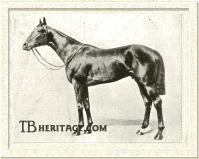
Let Fly | | The younger of the siblings produced by the union of White Eagle and Gondolette was the colt LET FLY, a truly high class animal. Let Fly took the New Stakes and the Dewhurst Plate at two and the Champion Stakes at three. He also finished second to Pommern in the Derby Stakes, a fine performance given that Pommern had won the Two Thousand Guineas and would add the St. Leger later that fall to land the Triple Crown. With the Tully Stud being gifted to the British government, Let Fly was sold to the Argentine for stud duty.
|
Let Fly survived the hazards of World War I ocean travel and landed in Argentina safely. There, he proved a fair stallion, his best representative being the filly Lye, heroine of the Gran Premio Seleccion (Argentine Oaks) in 1921. Efilet, Divita, and Yerbera were each daughters of Let Fly who became the second dams of Argentine classic winners, and Yerbera was also the third dam of yet another.
In 1912, Col. Hall Walker disposed of Gondolette, sending her to the Newmarket December sales. Her only winners to date were Lolette and Great Sport; Dolabella and Let Fly not yet having reached the races. Gondolette was in foal to Minoru, the son of Cyllene which Col. Hall Walker had leased to King Edward VII and for whom he won the Two Thousand Guineas and Derby.
Among the prospective purchasers at the Newmarket sale were two gentlemen in the employ of the 17th Earl of Derby--trainer George Lambton and Walter Alston, stud manager for Lord Derby. All three gentlemen, the Earl and his two advisers, agreed Gondolette would be a wise purchase. Lord Derby's two premier stallions were Swynford and Chaucer, both out of Pilgrimage's daughter Canterbury Pilgrim. Lord Derby, Lambton, and Alston were intrigued by the idea of being able to inbreed to Pilgrimage by mating either Swynford or Chaucer to Gondolette. It afforded the opportunity of inbreeding via a son of Pilgrimage--Gondolette's sire Loved One--and via a daughter of Pilgrimage--the aforementioned Canterbury Pilgrim.
But first, Gondolette had to drop the foal she was carrying by Minoru. Little did Lord Derby realize that by his purchase of Gondolette for 1500 guineas, he would be getting a package deal, for the foal she was carrying was a filly, named in due course SERENISSIMA. Both mother and daughter would proceed to make extraordinary contributions to the Derby stud.
|
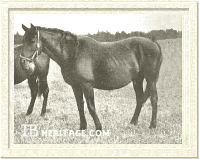
Serenissima | | SERENISSIMA had an abbreviated turf career due to the wartime restrictions on racing. She was winless as a two-year-old and won two races and £333 as a three-year-old. As a broodmare, she proved outstanding. As a daughter of Gondolette, she provided yet another opportunity for inbreeding to Pilgrimage. Mated to Chaucer, she produced the remarkable filly Selene.
Due to her small stature, Selene was not entered for the classics. This proved unfortunate, as Selene emerged as one of the best fillies seen on a British racecourse since the days of Sceptre and Pretty Polly. Selene won 16 of her 22 lifetime starts, including the Cheveley Park Stakes at two and the Park Hill Stakes, generally considered the fillies' St. Leger, at three.
|
As a broodmare, Selene was exemplary, for she became the dam of Derby winner and six-time leading sire Hyperion; the full brothers Pharamond II and Sickle, both imported to the United States for stud duty where both became important sires; Night Shift, winner of the Yorkshire Oaks; Hunters Moon, exported to Argentina for stud duty where he proved quite successful, ranking in the top ten Argentine sires three times and leading the Argentine broodmare sire list once; and All Moonshine, dam of Mossborough, a good stakes performer and sire of the top performers Ballymoss, Anticlea, Craighouse, Cavan, and Noblesse. All Moonshine was also the third dam of leading Australian sire Sir Tristram. Other winners tracing to Gondolette via Serenissima and Selene included Eyewash, Ardale, Collyria, Mountain Lodge, Raise You Ten, and American multiple stakes winner Variety Road.
Mated to Swynford, Serenissima became the dam of Tranquil, a strapping 16.3 hand bay filly who became the best filly of her generation in 1923 with victories in the One Thousand Guineas, St. Leger, Newmarket Oaks, Jockey Club Cup, and Liverpool St. Leger. It was a severe disappointment to Lord Derby that Tranquil failed to make any significant impact as a broodmare. A full brother to Tranquil, named Schiavoni, was a winner of the Liverpool Spring Cup and was an indifferent sire, his most important offspring being the filly Schiaparelli, dam of Lord Derby's filly Herringbone, winner in 1943 of the One Thousand Guineas and St. Leger, run as war substitute races at Newmarket.
Sent outside the Stanley House Stud to be mated with Son-in-Law, Serenissima produced Bosworth, a winner of the Ascot Gold Cup and a decent stallion, with St. Leger winner Boswell, and Jockey Club Stakes winner and major French sire Plassy to his credit.
|
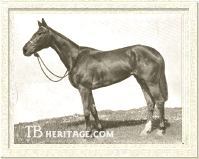
Ferry | |
Gondolette was sent to the court of Swynford, but came up barren for 1914. Sent again to Swynford, Gondolette produced the filly FERRY in 1915. Ferry won but one race during her racing career, but it was a classic, for she captured the One Thousand Guineas, and dead-heated for second in the Oaks, won by My Dear.
Ferry was not a success as a broodmare, and eventually was sold to go to Poland in 1930 at the age of fifteen. Ferry's daughter Mayflower, by Gay Crusader, was sold to the Argentine, and she became the second dam of the full brothers Mamboreta and Manganga, sons of Lord Derby's former champion Gulf Stream, who had been sold to Argentina for stud duty. Both colts became Argentinean classic winners. |
Gondolette suffered some problems in the next few years after the arrival of Ferry. In 1916 she foaled dead twins, she was barren in 1917, and then produced another set of dead twins in 1918. Then came the Chaucer filly CASA D' ORO. This filly was a winner and produced a winner. Gondolette had no foal in 1920, and was mated again to Swynford.
The resulting foal, a bay colt, arrived in the spring of 1921. He was given the name SANSOVINO, after the Renaissance artists Andrea and Jacopo Sansovino. And the equine Sansovino was nearly a work of art--a tall, statuesque bay colt. As a juvenile, Sansovino was out twice, and won both his races, the Ham Stakes at Goodwood and the Gimcrack Stakes at York. Trainer George Lambton kept the colt in cotton wool as a two-year-old, realizing that the muscular colt would need time to develop and might not be able to compete against the more precocious juveniles of his generation in races like the Middle Park Plate, which was won by the brilliant Grand Parade colt Diophon.
Come time to run the classics in the spring of 1924, Lambton left the Two Thousand Guineas to Diophon, who won with ease. Sansovino had his Derby prep in a small race at Birmingham. Then, in a home gallop, he devastated his competition--the previous year's St. Leger winner -- his near relative Tranquil -- and Pharos, runner-up to Papyrus in the previous year's Derby. |
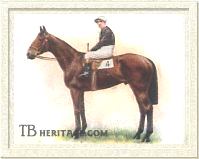
Sansovino | |
The Derby was run in a torrential downpour. There had been four straight days of rain, and the new precipitation rendered parts of the Epsom course a quagmire. The conditions failed to bother Lord Derby's colt. Under young rider Tommy Weston, Sansovino galloped his opposition into remorseless submission, winning by six lengths. Another Swynford son, Viscount Astor's St. Germans, finished a courageous second, while Diophon struggled home twelfth. The mastery of Sansovino's victory gained even more prestige as time went on, as St. Germans would go on to win the Coronation Cup and Doncaster Cup, Polyphontes, who ran fifth, would later win two runnings of the Eclipse Stakes, and Salmon Trout would go on to capture the St. Leger. |
The Derby victory by Sansovino was tremendously popular, and the Earl was given a well-deserved reception as he led his champion to the winner's enclosure. Sansovino's victory gave the Stanley family its first Derby win since 1787, when Lord Derby's ancestor, the 12th Earl, enjoyed success with Sir Peter Teazle.
After his dominant performance at Epsom, Sansovino was never quite as good again. In seven races after that rainy afternoon, he won only twice. He took the Prince of Wales's Stakes at Ascot later that summer, but was no match for Salmon Trout in the St. Leger, his unplaced run attributed to a cough he had recently suffered. At four, Sansovino won only the Spring Stakes at Lingfield Park.
Sansovino served his stallion duties at the Earl's Plantation Stud near Newmarket, and though he was considered a disappointing stallion, he certainly was not a failure. Some of the more notable progeny of Sansovino include: Jacopo, winner of four races, including the Princess of Wales's Stakes, later sent to America as a stallion, where he came up with champion filly Jacola, dam of American classic winner Phalanx; Sandwich, winner of the St. Leger; Sans Peine, winner of the Goodwood Cup; Buckleigh, winner of the Jockey Club Cup, Manchester Cup, and third in the St. Leger; and Monument, winner of the Craven Stakes, Limekiln Stakes, and Coronation Cup.
Two of Sansovino's daughters were important. Sansonnet produced Tudor Minstrel, winner of the Two Thousand Guineas and a major sire. Sansovino's daughter Salvia produced the fine stayer Zarathustra, winner of the Irish Derby, Irish St. Leger, Ascot Stakes, Goodwood Cup, and Ascot Gold Cup. Sansovino died at the age of nineteen in October of 1940.
Having produced her best offspring at the advanced age of nineteen, it was probably not surprising that Gondolette's last few foals, with one exception, were no more than ordinary. DOMENICO, a full brother to Sansovino arrived in 1922. He was a winner of one race.
PIAZZETTA, foaled in 1923, was sired by Chaucer's son Stedfast. Piazzetta won two of her five starts as a two-year-old, the Redfern Stakes at Kempton Park and the Criterion Nursery Handicap at Newmarket. At three, she won the minor Avon Stakes and placed in two minor stakes at Liverpool. Her most significant offspring was the Pharos filly Harbour Light. This marked extreme inbreeding, since Pharos was out of a Chaucer mare. Harbour Light was thus inbred 3x3 to Chaucer and 5x5x4 to Pilgrimage. The intense inbreeding failed to produce anything exceptional, as Harbour Light was only a minor winner. Sold to go to France, Harbour Light became the second dam of the French-bred Thunderhead, winner of the English Two Thousand Guineas in 1952.
Barren in 1924, Gondolette foaled a full sister to Piazzetta in 1925. Named VENDRAMINA, she never raced, but bred two winners, including Avenger, who won the three mile-four furlong Lancashire Steeplechase in 1934.
Gondolette died soon after the birth of her last foal, at the age of 23. It is amazing to realize that when the Earl of Derby purchased Gondolette, in foal with Serenissima, as a means of inbreeding to Pilgrimage, the Derby stud would reap a veritable bounty of classic performers. By mating Gondolette with Swynford to give the offspring a 3x3 inbreeding to Pilgrimage, two classic winners were the result. By mating her daughter Serenissima to both Swynford and Chaucer, which gave the resultant offspring 3x4 inbreeding to Pilgrimage, came yet another classic winner, as well as a filly who was a champion on the track and later one of the most influential broodmares of the 20th century. All told, the acquisition of the in-foal Gondolette brought five classic winners over the years to the Stanley family -- Tranquil, Ferry, Sansovino, Hyperion, and Herringbone -- as well as stallions who made a tremendous impact on Thoroughbred breeding around the world -- Hyperion, Pharamond II, and Sickle. Not bad for an initial outlay of only 1500 guineas.
-- Liz Martiniak
|
|
|
|

